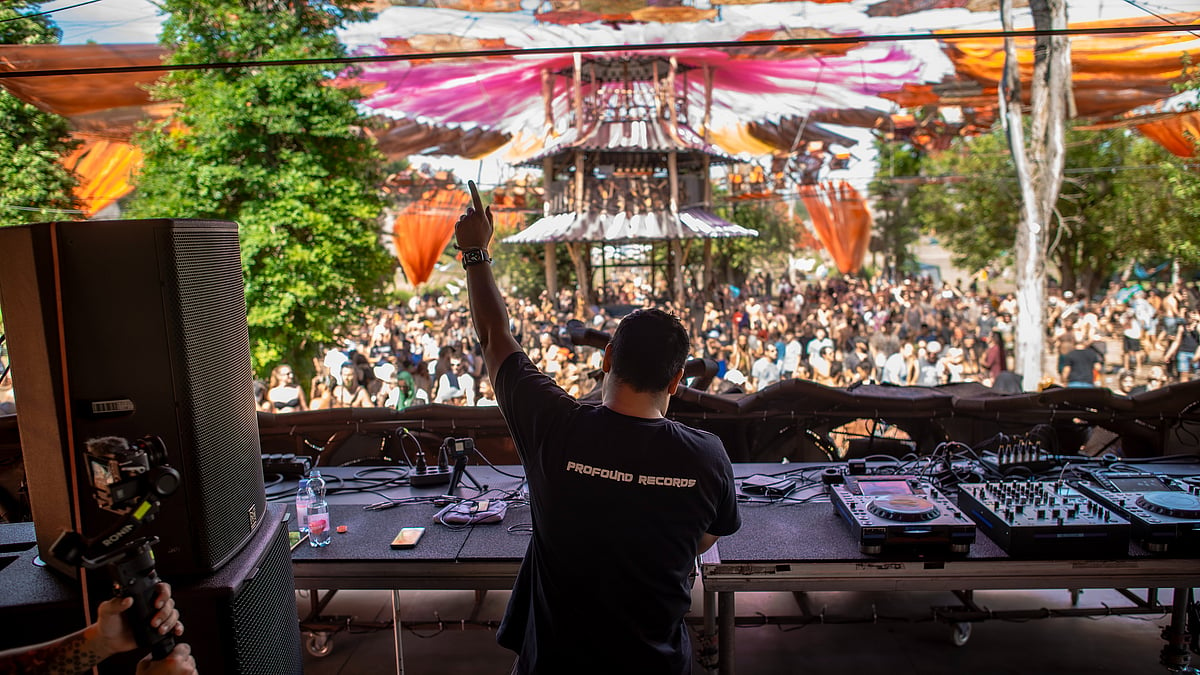Psytrance Is Back in India! It's Thriving In Goa Beaches & Top Metros
From Goa’s moonlit beaches to rooftops and raves across India, psytrance is pulsing through the country’s veins again

1975: Moonlit shores of Goa’s Anjuna Beach teem with sunburnt seekers. Runaways, hippies, mystics, dropouts — singed by Western materialism and looking to transcend — mill around handcrafted wooden stages amid a cocktail of incense, hashish and possibility. Soon after tambourines and sitars ignite the mood, basslines from makeshift sound systems and patched-together tape decks come alive. Psychedelic music washes over the land of feni.
Through the night, flowing kurtas, beaded necklaces, mirrored sunglasses and matted dreadlocks pulsate with freedom; their altered states fused by LSD, a powerful drug now banned. Acid rock and proto-electronica stir a generation into spiritual awakening. Psychedelia becomes a genre as well as a gateway.
Fast-forward 50 years later. Psychedelia is witnessing a resurgence in India — now as psytrance — across theatres from rooftops and neon-lit clubs in metros to raves in valleys, forests and deserts.
Curious minds and inked limbs are now mingling with Ableton Live, UV-reactive nano-fabrics, cyberpunk streetwear, LED masks and goggles, AI-driven sound design, precision-engineered subwoofers, and immersive virtual reality experiences. Soaking in synesthetic stews now are techies, ‘psychonauts,’ artists and urban nomads. The trance may have transformed but its quest to dissolve boundaries hasn’t.
Beyond the dancefloor
“Psytrance is pure freedom,” says Gurugram-based digital marketer Nidhi Kalra. “With psytrance, I experience music as a journey through my mind,” enthuses Prajakta Ganorkar, a designer from Navi Mumbai. “Nothing else matters when I dance to psy,” says Bengaluru-based event manager Awais Surti.
“Psytrance has always had deep roots in India,” says Bharat Bindal aka StarLab, one of India’s leading psytrance producers signed to Digital Om Productions. “The resurgence is partly due to nostalgia and a growing counterculture that values altered states, connection and escape from mainstream norms.”
“I’ve witnessed psytrance blossom into a full-blown, ever-evolving ecosystem,” says noted psytrance artist, producer and sound engineer Bilas Rajderkar, who performs as Spinal Fusion and founded Profound Records in 2012. “When I first started playing, most gigs were either in Goa or low-key, secret gatherings. We now see full-scale festivals with proper production.”
While most Indian psytrance festivals do not disclose precise attendance numbers, regulars vouch for the growing influx and diversity of fans. The Hilltop Festival on Goa’s Vagator waterfront, for example, is said to have drawn renowned international artists and well over 5,000 attendees last year. Cities like Delhi, Mumbai, Bengaluru and Pune have become essential stops for international acts as well as Indian artists. Festivals like Indrasan, Parvati Peaking, Shiva Squad, Electric Mahadeva and Kundalini Shakti have turned Parvati Valley, Manali and Dharamsala into hotspots for psytrance enthusiasts. Interestingly, Indian Spirit, Germany’s largest psytrance festival that began over 25 years ago, continues to celebrate Goan trance with nearly 15,000 guests.
Gen Z and millennial listeners are increasingly turning to psytrance for therapy, meditation and self-exploration as well. “There’s this whole wave of Indian ravers now who are genuinely connected to the culture,” says Rajderkar. “The festivals are more than just music. You’ve got yoga zones, eco-conscious set-ups, healing spaces — psytrance has evolved into an experience,” he adds. Bindal observes, “Psytrance offers experimentative younger audiences something raw and immersive that feels more meaningful and less commercial.”
Harmonic alchemy
India presents the perfect cultural crucible for sound and spirit to converge. “Certain ragas are designed to evoke altered states or deep emotions, which fits perfectly with psychedelic music,” says Bindal, who has his roots in Hindustani classical music.
Sandeep Khurana, a California-based singer, composer and producer of over 100 albums, highlights a growing demand for spiritually-inclined psychedelic sounds. “The genre combines elements of psychedelia with spiritual themes, often blending traditional ethnic Indian instruments with modern elements like strings, flutes and synths,” he says. “This fusion creates a captivating sound that promotes mindfulness and relieves stress. Its therapeutic benefits are being further explored in alternative as well as conventional therapies.”
Future frequencies
DJ Mash, active in psytrance since the mid-90s as ‘Pulse’, says, “Psytrance has been booming in India for a while. The Hilltop Festival, for example, has flipped from 90% foreigners in 2008 to as many Indians now. Yet, permissions remain a nightmare, so much so that despite a successful decade-long run in Goa, Karakus Marakus had to relocate to Thailand.”
“Psytrance festivals in India are stereotyped and often face needless stigma as law enforcement views them through narcotics laws instead of culture,” says Abhinav, founder of Himalayan Music Festival. “Psytrance’s growing popularity should ideally open up newer avenues for sustainable music tourism, new talent and local businesses. However, bureaucracy and regulations create ambiguity instead of clarity.”
Despite visa constraints, limited industry support and a crowded global scene, Indian artists such as StarLab and Spinal Fusion are gaining global recognition with their distinct blends of mysticism, rhythm and innovation — performing at marquee international festivals in Europe and South America, and collaborating with top overseas artists such as Avalon, Burn in Noise, Mad Maxx, Ajja, Killerwatts, Spectra Sonics, Outsiders and Symbolic.
AI and digital tools are further energising sonic innovation and experimentation. “Tasks like sound design, mixing and mastering are becoming more efficient. Visual content is now heavily AI-driven,” says Bindal.
Rajderkar is upbeat about the genre’s potential. “With the internet, it’s so much easier to release music, reach new listeners and collaborate internationally,” he says. “If you stay true to your sound and keep pushing forward, there’s plenty of space to grow.” The next wave of Indian psytrance — louder, bolder and strikingly homegrown — might well be what the healer ordered for our overstimulated digital age.
RECENT STORIES
-
-
-
-
-